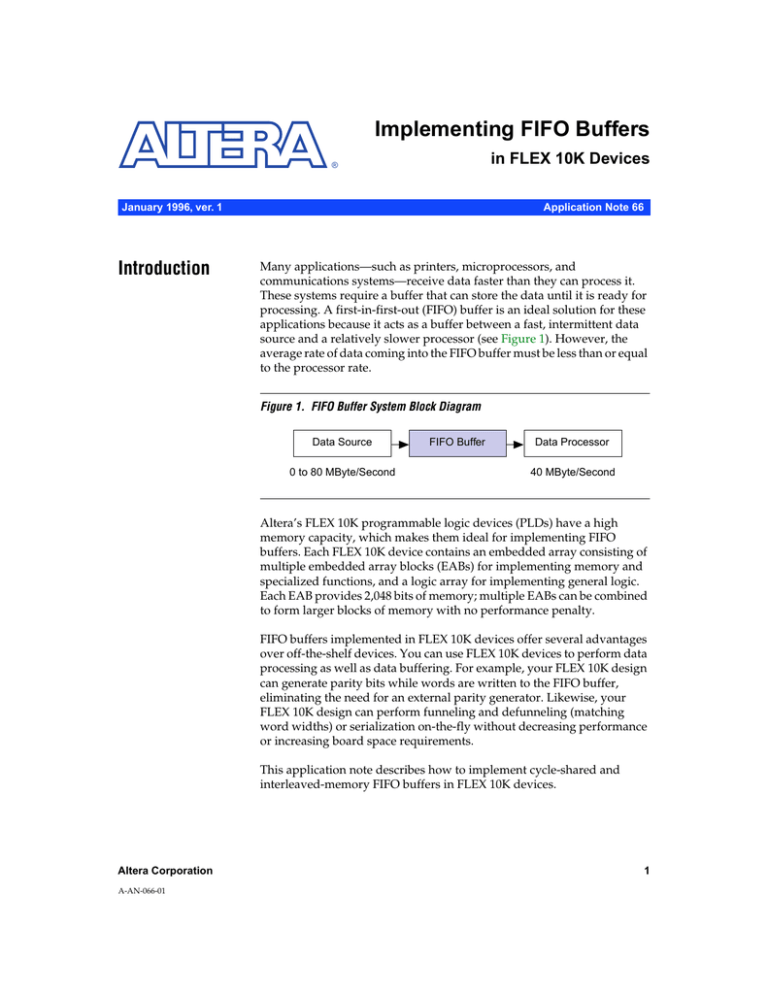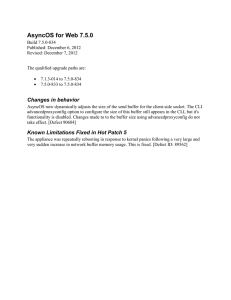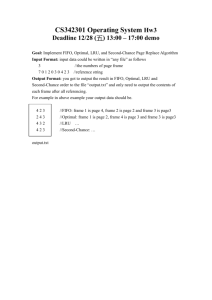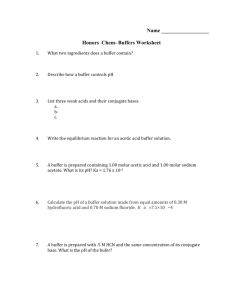
Implementing FIFO Buffers
in FLEX 10K Devices
®
January 1996, ver. 1
Introduction
Application Note 66
Many applications—such as printers, microprocessors, and
communications systems—receive data faster than they can process it.
These systems require a buffer that can store the data until it is ready for
processing. A first-in-first-out (FIFO) buffer is an ideal solution for these
applications because it acts as a buffer between a fast, intermittent data
source and a relatively slower processor (see Figure 1). However, the
average rate of data coming into the FIFO buffer must be less than or equal
to the processor rate.
Figure 1. FIFO Buffer System Block Diagram
Data Source
0 to 80 MByte/Second
FIFO Buffer
Data Processor
40 MByte/Second
Altera’s FLEX 10K programmable logic devices (PLDs) have a high
memory capacity, which makes them ideal for implementing FIFO
buffers. Each FLEX 10K device contains an embedded array consisting of
multiple embedded array blocks (EABs) for implementing memory and
specialized functions, and a logic array for implementing general logic.
Each EAB provides 2,048 bits of memory; multiple EABs can be combined
to form larger blocks of memory with no performance penalty.
FIFO buffers implemented in FLEX 10K devices offer several advantages
over off-the-shelf devices. You can use FLEX 10K devices to perform data
processing as well as data buffering. For example, your FLEX 10K design
can generate parity bits while words are written to the FIFO buffer,
eliminating the need for an external parity generator. Likewise, your
FLEX 10K design can perform funneling and defunneling (matching
word widths) or serialization on-the-fly without decreasing performance
or increasing board space requirements.
This application note describes how to implement cycle-shared and
interleaved-memory FIFO buffers in FLEX 10K devices.
Altera Corporation
A-AN-066-01
1
AN 66: Implementing FIFO Buffers in FLEX 10K Devices
Cycle-Shared
FIFO Buffer
In a cycle-shared FIFO buffer, one or more EABs provide the highspeed memory; all other required logic is efficiently implemented in
the FLEX 10K logic array.
To implement cycle sharing, the EAB must be clocked at twice the
frequency as the rest of the system, allowing both the read and write
cycles to occur within one system Clock cycle. Figure 2 shows a
cycle-shared FIFO buffer.
Figure 2. Cycle-Shared FIFO Buffer Schematic
RREQ
RRQ
Read Pointer
(Counter)
D
Q
ENA
EMPTY
Q[]
EAB (1)
0
1
Write Pointer
(Counter)
WREQ
WRQ
D
Q
A[]
Q[]
D[]
ENA
Q[]
ENA
FULL
Q[]
DATA
D[]
D[]
Q[]
WE
VCC
D
Q
D
Q
CLOCK
CLOCKx2
Note:
(1) Multiple EABs can be combined to form larger RAM blocks if desired.
2
Altera Corporation
AN 66: Implementing FIFO Buffers in FLEX 10K Devices
The read and write pointers are implemented as counters in the logic
array. When a word is written to the FIFO buffer, the write counter
is incremented by one; when a word is read from the FIFO buffer, the
read counter is incremented by one. A 2-to-1 multiplexer is used to
multiplex the address lines from the read and write counters to the
address lines of the EAB. The select input of the 2-to-1 multiplexer is
continuously toggled by a flipflop synchronized by the Clock.
To request a read, the system asserts Read Request (rreq); to request
a write, the system asserts Write Request (wreq). Reads are
performed on the first half of the system Clock cycle, and writes are
performed on the second half. This scheme allows the result of the
read operation to be available to the system before the start of the
next system Clock cycle.
Before the rising edge of the first clockx2 cycle, the contents of the
read counter are multiplexed onto the address lines of the EAB. On
the rising edge of clockx2, the EAB drives out the data stored at
that particular address. If a read is requested, the output of the EAB
is latched on the second rising edge of clockx2.
On the rising edge of the first clockx2 cycle, the data to be written
to the FIFO buffer is latched into registers so it will be available on
the rising edge of the second clockx2 cycle.
Before the rising edge of the second clockx2 cycle, the contents of
the write counter are multiplexed onto the address lines of the EAB.
The rising edge of clockx2 triggers the write pulse circuit within
the EAB, and writes the data bus value to the EAB.
Clock skew between the two user-supplied Clocks lowers the
maximum operating frequency of the FIFO buffer. For example, a
Clock skew of 2 ns adds 2 ns to the minimum Clock period. To
accurately simulate this behavior, the skew must be manually
modeled in MAX+PLUS II by inserting a delay between the two
Clock sources (a 2-ns delay in this example). MAX+PLUS II
simulation does not automatically show this reduction in
performance because the Clock skew is generated external to the
device. Figure 3 shows the functional waveforms for cycle-shared
FIFO buffers in FLEX 10K devices.
Altera Corporation
3
AN 66: Implementing FIFO Buffers in FLEX 10K Devices
Figure 3. FLEX 10K Cycle-Shared FIFO Buffer Functional Waveforms
Simultaneous Read
and Write Request
Write Request Only
CLOCK
CLOCKx2
WREQ
RREQ
EAB A
RD_PTR
EAB D
DATA0[]
WR_PTR
RD_PTR
WR_PTR
DATA1[]
RD_PTR
DATA2[]
EAB WE
EAB Q
Q
InterleavedMemory FIFO
Buffer
4
DATA0[]
RD_DATA1[]
RD_DATA0[]
DATA1[]
RD_DATA2[]
RD_DATA1[]
An interleaved-memory FIFO buffer pipelines blocks of memory,
thereby increasing the operating frequency. In a FIFO buffer, every
memory reference points to a consecutive memory location. The
interleaved-memory FIFO buffer always stores consecutive words in
different memory blocks, which reduces cycle time. Figure 4 shows
how the interleaved-memory FIFO buffer accesses consecutive
words from two distinct memory blocks.
Altera Corporation
AN 66: Implementing FIFO Buffers in FLEX 10K Devices
Figure 4. Read/Write Memory References from 2 Blocks of Memory
In this figure, the binary numbers represent memory locations (addresses).
Empty FIFO
After One Write
After Another Write
After One Read
Memory Block 0
Memory Block 0
Memory Block 0
Memory Block 0
000
000
000
000
010
010
010
010
100
Write
Read
100
Read
100
110
110
Write
110
Memory Block 1
Memory Block 1
Memory Block 1
Memory Block 1
001
001
001
001
011
011
011
011
101
101
111
111
100
101
111
Read
Write
Write
Read
110
101
111
Although an interleaved-memory FIFO buffer can use any number
of memory blocks, this example uses two. Using two memory blocks
is ideal for simultaneous reads and writes; while a write is
performed on one block, a read is performed on the other block. The
staging register stores the next word to be read from each block,
which prevents a conflict such as the FIFO buffer control circuitry
needing to read from and write to the same memory block.
You can use the low order bits of the read and write pointers to select
different blocks of memory. If only two memory blocks are used,
then only the least significant bit (LSB) of the read and write pointers
are needed to select each memory block. If the contents of the read or
write pointer are even, Memory Block 0 is selected; if the contents of
the read or write pointer are odd, Memory Block 1 is selected.
The interleaved-memory FIFO buffer in Figure 5 also uses two
blocks of memory. Each block of memory is implemented in one or
more EABs and is accessed with dedicated read and write pointers.
Because each memory block has dedicated read and write pointers,
two toggle flipflops (designated by r0 and w0 in Figure 5) are used
to emulate the LSB of the read and write pointers. The data source
writes to Memory Block 0 when w0 is low and a wreq has been
granted; the data source writes to Memory Block 1 when w0 is high
and a wreq has been granted.
Altera Corporation
5
AN 66: Implementing FIFO Buffers in FLEX 10K Devices
Figure 5. Interleaved-Memory FIFO Buffer
The toggle flipflops that generate R0 and W0 are not shown. RRQ and WRQ are generated as shown in Figure 2. SR 0
and SR 1 are staging registers for Memory Block 0 and Memory Block 1, respectively. RENA0 and RENA1 are the outputs
of a simple state machine.
WREQ & !W0
WR_PTR0
(Counter)
Q[]
ENA
WRQ & (EMPTY or ONE)
SR 0
DATA
RREQ & !R0
RD_PTR0
(Counter)
Q[]
ENA
1
0
Memory Block 0
1
0
RENA0
D[]
ENA
A[]
OUT_BUFF
Q[]
DATA
0
1
D[]
RRQ
D[]
ENA
Q[]
R0
WRQ & !W0
WE
WR_PTR1
(Counter)
WREQ & W0
Q[]
DATA
RD_PTR1
(Counter)
RREQ & R0
SR 1
ENA
Q[]
RENA1
D[]
ENA
Memory Block 1
1
0
A[]
ENA
DATA
WRQ & W0
1
0
D[]
Q[]
WRQ &
(EMPTY or
ONE)
WE
CLOCK
When a read operation is performed on an EAB, the data is read from
the staging register for that EAB. If a write operation is being
performed, the staging register is updated on the next Clock cycle. If
a write operation is not being performed, the staging register is
updated immediately. If an EAB is empty during a write operation,
the data source simultaneously writes to the EAB and its associated
staging register. This scheme ensures that the next word to be read
from an EAB is always available.
6
Altera Corporation
AN 66: Implementing FIFO Buffers in FLEX 10K Devices
Figure 6 illustrates this algorithm by showing the state of the
interleaved-memory FIFO buffer during three consecutive Clock
cycles. On the first Clock cycle, r0 and w0 are both low, and both
read and write requests are granted. Because r0 and w0 are both low,
the data source writes to Memory Block 0, and the content of SR 0 is
transferred to the output buffer. On the next Clock cycle, SR 0 will be
updated.
Figure 6. Example Operation of Interleaved-Memory FIFO Buffer
(Read & Write)
Clock Cycle 1
R0 = W0 = 0
Write 0
Read 0
Write 1
(Read)
Clock Cycle 3
R0 = W0 = 0
Memory Block 0
Memory Block 0
Memory Block 0
Data 0
Data 8
Data 8
Read 0
Data 8
Data 2
Write 0
Data 2
Data 2
Write 0
Data 2
Data 4
Read 0
Data 4
Write 0
Memory Block 0
Data 4
Data 4
Data 6
Data 6
Data 6
Data 6
Memory Block 1
Memory Block 1
Memory Block 1
Memory Block 1
Data 1
Data 9
Data 9
Data 1
Write 1
Data 3
Read 1
(Read & Write)
Clock Cycle 2
R0 = W0 = 1
Data 5
Read 1
Read 0
Data 3
Write 1
Data 3
Data 5
Read 1
Data 5
Write 1
Data 3
Data 5
Data 7
Data 7
Data 7
SR 0
SR 0
SR 0
SR 0
Data 2
Data 2
Data 4
Data 6
SR 1
SR 1
SR 1
SR 1
Data 3
Data 3
Data 3
Data 5
Output Buffer
Output Buffer
Output Buffer
Output Buffer
Data 1
Data 2
Data 3
Data 4
Altera Corporation
Read 1
Data 7
7
AN 66: Implementing FIFO Buffers in FLEX 10K Devices
During the second Clock cycle, r0 and w0 are both high, and both
read and write requests are granted. The data source writes to
Memory Block 1 and the contents of SR 1 are transferred to the
output buffer. The data processor reads from Memory Block 0, and
SR 0 is updated.
During the third Clock cycle, r0 and w0 are both low and a read
request is granted. SR 0 is transferred to the output buffer, and both
SR 0 and SR 1 are updated. The r0 flipflop is toggled so that it is high
on the next Clock cycle.
FIFO Buffer Status
Signals
Status signals are needed to monitor the operation of both
interleaved-memory and cycle-shared FIFO buffers. The empty,
full, and threshold output signals indicate to the controlling
system when the FIFO buffer is empty, is full, or has reached a predetermined level, respectively. These signals can be generated by
using a simple up/down counter. When a write occurs, the
up/down counter increments by one; when a read occurs, the
up/down counter decrements by one. This scheme keeps the current
size of the FIFO buffer always available to the system. Figure 7
shows a schematic of the FIFO buffer status signals.
Figure 7. FIFO Buffer Status Signals
Status Counter
WRQ
RRQ
CLOCK
THRESHLEVEL
UP/DN
Q=0
ENA
Q
Q = Max.
Q>y
EMPTY
FULL
THRESHOLD
The empty output signal is asserted when the output of the
up/down counter is zero. Read requests are not granted when the
FIFO buffer is empty, which prevents the system from reading nonvalid data.
The full output signal is asserted when the up/down counter
reaches a predefined maximum value. When the FIFO buffer is full,
requests to write to the FIFO buffer are not granted, which prevents
the controlling system from inadvertently overwriting unread data.
8
Altera Corporation
AN 66: Implementing FIFO Buffers in FLEX 10K Devices
The system needs to know when the FIFO buffer is almost full or
almost empty. The designer determines when the system should flag
this condition by choosing the value of the threshlevel input.
When the contents of the up/down counter are greater than the
threshlevel input (Q > y in Figure 7), the threshold output is
asserted.
FIFO Buffer
Macrofunctions
The cycle-shared FIFO buffer macrofunction, csfifo, is currently
available in MAX+PLUS II. Contact Altera Applications for
availability of the interleaved-memory FIFO buffer macrofunction.
Both macrofunctions use functions from the library of parameterized
modules (LPM)—a set of architecture-independent modules that
completely describes the logical operation of a circuit. You can easily
control the size of the macrofunctions by adjusting the parameters of
the LPM function. Device resources are not wasted because the size
of the FIFO buffer is not fixed.
When you use the FIFO macrofunction, you must specify the value
of two parameters, lpm_width and lpm_numwords, which
represent the word size and depth of the FIFO buffer, respectively.
Table 1 lists the input and output ports for the FIFO macrofunctions.
Table 1. Ports to FIFO Macrofunctions
Port
Type
Altera Corporation
Ports
Description
Input
rreq
Request to read from the FIFO buffer.
Input
wreq
Request to write to the FIFO buffer.
Input
data
Data to be written into the FIFO buffer.
Input
threshlevel Level at which the threshold signal is asserted.
Input
clock
System Clock.
Input
clockx2
Internal Clock of the FIFO buffer (must operate
at twice the frequency of the system Clock). This
port is only available in csfifo.
Output
q
Data from last read of the FIFO buffer.
Output
full
Indicates that the FIFO buffer is full.
Output
empty
Indicates that the FIFO buffer is empty.
Output
threshold
Indicates that the FIFO buffer contains more
than the threshlevel number of words.
9
AN 66: Implementing FIFO Buffers in FLEX 10K Devices
®
2610 Orchard Parkway
San Jose, CA 95134-2020
(408) 894-7000
Applications Hotline:
(800) 800-EPLD
Customer Marketing:
(408) 894-7104
Literature Services:
(408) 894-7144
10
Altera, MAX, MAX+PLUS, and FLEX are registered trademarks of Altera Corporation. The following are
trademarks of Altera Corporation: MAX+PLUS II and FLEX 10K. Altera acknowledges the trademarks of other
organizations for their respective products or services mentioned in this document. Altera products are
protected under numerous U.S. and foreign patents and pending applications, maskwork rights, and
copyrights. Altera warrants performance of its semiconductor products to current specifications in accordance
with Altera’s standard warranty, but reserves the right to make changes to any products and services at any
time without notice. Altera assumes no responsibility or liability arising out of the application or use of any
information, product, or service described herein except as expressly agreed to in writing
by Altera Corporation. Altera customers are advised to obtain the latest version of device
specifications before relying on any published information and before placing orders for
products or services.
U.S. and foreign patents pending.
Copyright 1996 Altera Corporation. All rights reserved.
Altera Corporation
Printed on Recycled Paper.




